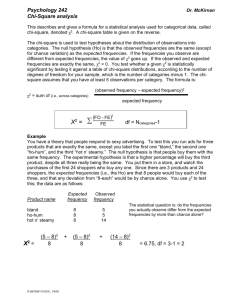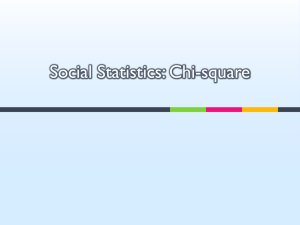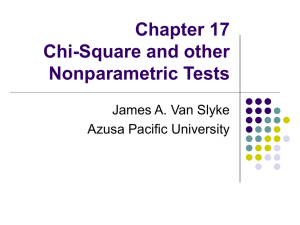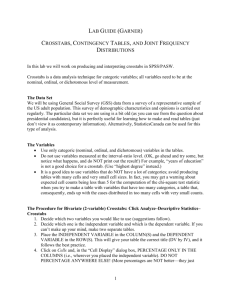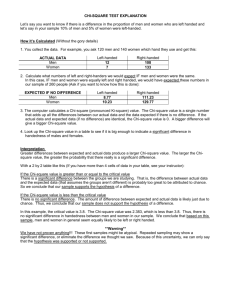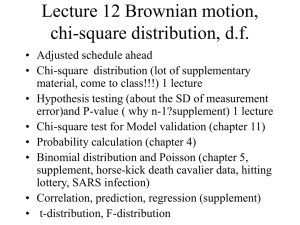Chi-Square
advertisement
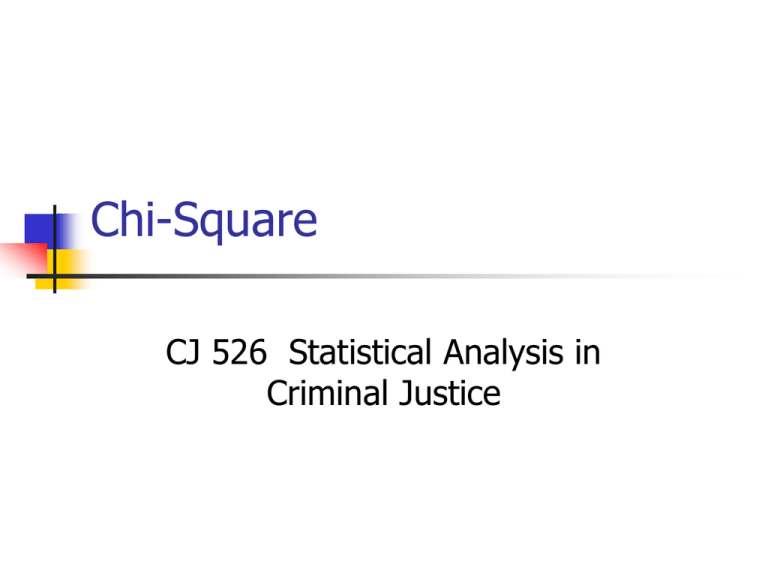
Chi-Square CJ 526 Statistical Analysis in Criminal Justice Parametric vs Nonparametric Parametric DV: Interval/Ratio Nonparametric DV: nominal/ordinal Chi-Square Test for Goodness of Fit One sample, DV is at Nominal/Ordinal Level of Measurement This test , the chi-square good of fit, determines whether the sample distribution fits some theoretical distribution Null Hypothesis 1. Population is evenly distributed the uniform distribution Or Some other distribution, such as the normal distribution The sample distribution is not different from the theoretical distribution (such as the uniform distribution or the normal distribution) Observed and expected frequency Observed: number of individuals from the sample who are classified in a particular category Expected frequency: the frequency for a particular category that is predicted from the null hypothesis Chi-Square Statistic Sum of (Observed - Expected)2 divided by Expected Degrees of Freedom df = C - 1 where C is the number of categories The degrees of freedom are the number of categories that are free to vary Interpretation If the null hypothesis is retained, the sample distribution is like that of the theoretical distribution If H0 is rejected, distribution is different from what is expected Report Writing: Results Section Null hypothesis retained: The results of the chi-square goodness of fit test were not statistically significant Null hypothesis rejected The results of the Chi-Square Test for Goodness of Fit involving <DV> were statistically significant, 2 (df) = <value>, p < .05. Report Writing: Discussion Section It appears as if the <sample> is (or is not) distributed as expected. Depends on the result Example Concerned about health, neither concerned or not concerned, not concerned about health Could assume that a sample would be equally split among these three categories i.e., 120 subjects, 40 would say concerned, 40 neither, 40 not concerned (uniform distribution) Example O E O-E (O-E)^2 /E 60 40 20 400 10 40 40 0 0 0 20 40 20 400 10 Chi square Chi square = 20 D.f. = 2 See p. 726 Chi square = 20, p < .01 The distribution is significantly different from the expected distribution Example Dr. Zelda, a correctional psychologist, is interested in determining whether the intelligence of delinquents enrolled in a state training school is normally distributed Distribution of Intelligence in the General Population IQ Range Z-score Percentage of General Population Below 60 -3 .0228 (23) 60-85 -2 .1359 (136) 86-100 -1 .3413 (341) 101-115 +1 .3413 (341) 116-130 +2 .1359 (136) 131+ +3 .0228 (23) Distribution of Intelligence in Dr. Zelda’s School Below 60 119 60-85 150 86-100 687 101-115 32 116-130 12 131+ 0 1. 2. 3. Number of Samples: 1 DV: IQ categories Target Population: delinquents enrolled in the state training school Inferential Test: Chi-Square Test for Goodness of Fit H0: The distribution of frequencies of the IQ categories for the sample will not be different from the population distribution of frequencies of the IQ categories H1: The distribution of frequencies of the IQ categories for the sample will be different from the population distribution of frequencies of the IQ categories If the p-value of the obtained test statistic is less than .05, reject the null hypothesis Calculations O E O-E (O-E)^2 /E 119 23 96 9216 401 150 136 14 196 1 687 341 346 119716 351 32 341 309 95481 280 12 136 124 15376 113 0 23 23 529 23 X2 (5) = 1169, p < .001 Reject H0 SPSS: Chi-Square Goodness of Fit Test Weight Cases Data, Weight Cases Check Weight Cases by Move weighted variable over to Frequency Variable Analysis Analyze, Nonparametric Statistics, Chi-Square Move DV to Test Variable List Enter Expected Values Results Section The results of the Chi-Square Test for Goodness of Fit involving the distribution of IQ categories for the state training school were statistically significant, X2 (5) = 1169, p < . 001. Discussion Section It appears as if the distribution of frequencies of the IQ categories for students enrolled in the state training school is different from the population distribution of frequencies of the IQ categories. Chi-Square Test for Independence Used to assess the relationship between two or more variables Null Hypothesis No relationship between the two variables (independent of one another) Or Alternative: the two variables are related to one another Degrees of Freedom df = (R - 1)(C - 1), Where R is the number of rows and C is the number of columns in a bivariate table (review bivariate table) Example Dr. Cyrus, a forensic psychologist, is interested in determining whether gender has an effect on the type of sentence that convicted burglars receive Background Number of samples: 1 IV: Gender DV: Type of sentence received 1. 1. Nominal Target Population: convicted burglars Inferential Test: Chi-Square Test for Independence H0: There is no relationship between gender and type of sentence received H1: There is a relationship between gender and type of sentence received Create a bivariate table probation jail total male 14 80 94 female 46 20 66 60 100 160 Calculate expected values For each cell, row total times column total, divided by the total number of subject i.e., for the first cell, (94 x 60)/160 = 35 (66x60)/160 = 25, (94x100)/160 = 59, (66x100)/160 = 41 O E (O-E) (O-E)^2 /E 14 35 21 441 12.6 80 59 21 441 7.5 46 25 21 441 17.6 20 41 21 441 10.6 X2 (1) = 48.3, p < .001 Reject H0 Probation Jail Total Male 14 (35) 80 (59) 94 Female 46 (25) 20 (41) 66 60 100 160 SPSS: Chi-Square Test of Independence Analyze Descriptive Statistics Crosstabs Statistics Move DV into Columns Move IV into Rows Chi-Square Cells Percentage Rows Columns Results Section The results of the Chi-Square Test for Independence involving gender as the independent variable and type of sentence received as the dependent variable were statistically significant, X2 (1) = 48.3, p < .001. Discussion Section It appears as if gender has an effect on the type of sentence received. Assumptions Independence of Observations


